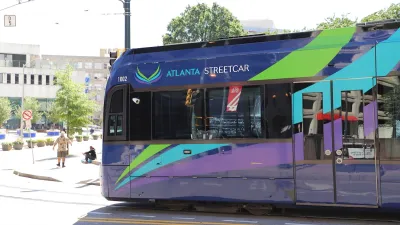Eric Jaffe reports on the growing use of "health impact assessments" (HIA), which are used in a similar fashion to environmental reviews, to determine the public health side effects of major projects.
Already in frequent use in Europe and Canada, "[a]n HIA, like an environmental review, evaluates the potential effects a major planning project might have on the public health of a surrounding community, and recommends certain actions needed to mitigate - or, in the case of health benefits, accelerate - those impacts," writes Jaffe.
As the effects of land use on public health become more prominent in the minds of planners, citizens, and officials, HIAs are a valuable tool in elucidating the direct connection between planning and design decisions and health outcomes. As an example, Jaffe explores the HIA completed for Atlanta's BeltLine project, which seeks to transform 22 miles of abandoned railroad near downtown Atlanta into parks, trails, transit, and development.
"Conducting the HIA required an interdisciplinary team of health professionals and planners to examine the BeltLine plans, compile all sorts of data on the community in the project's impact area, and compare these findings with existing public health literature. The HIA focused on several broad categories of health, from physical activity to access and equity to safety, and its 72 recommendations range from the broad and basic (Atlanta should speed up the BeltLine timeline) to the painfully specific (residential units should be at least 600 feet from high-volume roads to reduce impact of particulate matter)."
FULL STORY: How to Measure a Project's Health

Alabama: Trump Terminates Settlements for Black Communities Harmed By Raw Sewage
Trump deemed the landmark civil rights agreement “illegal DEI and environmental justice policy.”

Planetizen Federal Action Tracker
A weekly monitor of how Trump’s orders and actions are impacting planners and planning in America.

The 120 Year Old Tiny Home Villages That Sheltered San Francisco’s Earthquake Refugees
More than a century ago, San Francisco mobilized to house thousands of residents displaced by the 1906 earthquake. Could their strategy offer a model for the present?

In Both Crashes and Crime, Public Transportation is Far Safer than Driving
Contrary to popular assumptions, public transportation has far lower crash and crime rates than automobile travel. For safer communities, improve and encourage transit travel.

Report: Zoning Reforms Should Complement Nashville’s Ambitious Transit Plan
Without reform, restrictive zoning codes will limit the impact of the city’s planned transit expansion and could exclude some of the residents who depend on transit the most.

Judge Orders Release of Frozen IRA, IIJA Funding
The decision is a victory for environmental groups who charged that freezing funds for critical infrastructure and disaster response programs caused “real and irreparable harm” to communities.
Urban Design for Planners 1: Software Tools
This six-course series explores essential urban design concepts using open source software and equips planners with the tools they need to participate fully in the urban design process.
Planning for Universal Design
Learn the tools for implementing Universal Design in planning regulations.
Clanton & Associates, Inc.
Jessamine County Fiscal Court
Institute for Housing and Urban Development Studies (IHS)
City of Grandview
Harvard GSD Executive Education
Toledo-Lucas County Plan Commissions
Salt Lake City
NYU Wagner Graduate School of Public Service





























